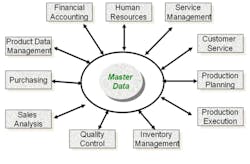CEOs and COOs care about how their companies are doing. They use key performance indicators (KPIs) to measure mission accomplishments and financial health. But what if the data they’re looking at is not accurate?
KPIs are typically compiled by the CFO with the help of an IT team and/or system. Each KPI answers a question, and the accuracy and relevancy of the KPIs is dependent on accurate, complete and timely data. Data is collected, converted into usable formats, and analyzed and integrated to calculate the KPIs. The findings are then disseminated to the requisite stakeholders: CEO, COO, operational managers, etc.
Smaller companies extract data from the enterprise resource planning (ERP) or core IT system into Excel spreadsheets and then manipulate the data to calculate the KPIs. Manual manipulation of the data makes the process prone to errors. Who is testing the spreadsheet calculations? The data is usually assumed to be accurate if the resulting spreadsheets balance and the KPIs are within expected ranges, but this can lead to decision-making based on inaccurate data.
One solution for smaller companies is to ask an independent consultant to perform a quick diagnostic benchmarking of their KPIs to validate the spreadsheets and assure management that the information is accurate. (Larger companies have business intelligence [BI] systems that extract data from the ERP system.)
Timely Access to Quality Data
The CEO or CFO who can capture meaningful information on a consistent basis adds more value and can improve business results. But timely access to quality data is often difficult or seemingly impossible.
A lack of good data leads to missed opportunities. In fact, Aberdeen Group recently published a research report that made it crystal clear: organizations where managers are able to find the information they require on a timely basis at least 80% of the time grew operating profits 16% year over year, compared to 13% for organizations where managers were not able to find information as timely.
Aberdeen Group’s report documents this problem: the demand for analysis and fast access to business data is rapidly increasing. As data environments grow in both size and complexity, meeting this demand has become more difficult, according to the May 2013 report entitled “Ever Harder and Faster: Managing the New Demands of Data Integration.”
Accurate data presented in a concise, meaningful fashion can be a competitive advantage to your corporate executives, your operations managers and indeed your entire team. One of the most common corporate issues is corrupt or unreliable data.
Without clean data, it’s impossible to use business intelligence to improve results. All too often corporate data suffers from inaccuracy and redundancy, commonly called “multiple sources of the truth.” This causes management to question the validity of KPIs and management reports.
The company must address the underlying cause for bad data. This requires independent analysis of:
• Data entry processes;
• Data entry standards and naming conventions;
• ERP system data validation techniques;
• Redundant data across multiple systems;
• Duplicate data (e.g., same customer with multiple names);
• Preventive, detective and corrective controls.
In project-based and some discrete manufacturers, this often means drilling down to the job cost data, but also to the entire job cost process by analyzing the following:
• Estimating;
• Design and engineering;
• Shop floor manufacturing;
• Quality control/inspection;
• Warehousing;
• Distribution/shipping;
• Installation;
• Service and support.
Effective data cleansing requires attention to key data elements such as:
• Customers, shipping locations, invoice terms, pricing tables;
• Products, descriptions, pricing tables, units of measure;
• Sales and commission calculations, sales categories;
• Vendors, payment terms, pricing and markup tables;
• Employee payroll, human resources and benefits.
Data Cleanliness and Data Relevance
Cleaning up the data may be a challenging process. But even more difficult may be evaluating which data is truly relevant for management’s review.
If the chief financial officer wants to deliver real value, two important issues must be addressed: data cleanliness and data relevance. Improving training, tools and system functionality will lead to more relevant information, but in order to effectively use this data to inform business decisions, management processes and information must be aligned with company objectives, strategies and tactics.
Two types of systems typically produce reporting for management decision purposes:
1. Enterprise resource planning systems are the engine for transaction processing. An ERP system will generate a return on investment by streamlining business processes and providing senior management with more accurate and timelier data, typically in the form of KPIs.
2. Business intelligence dashboards and scorecards accessed through personalized portals will allow senior management to access metrics that they can use to make informed decisions. Business intelligence refers to the applications, infrastructure, tools and best practices that enable access to and analysis of information to improve and optimize decisions and performance. Top performing companies use BI tools to assimilate accurate, timely, cross-functional data in an environment that enables rapid analysis and decision-making. Spreadsheets do not qualify as BI tools, as they can be prone to errors and typically do not handle complex data models.
Change Management
Change management—changing perceptions of what’s important to the bottom line in current circumstances—can become the real obstacle to a business intelligence initiative.
Employees can tank any corporate initiative, especially if they feel threatened by it. New or different KPIs to measure success are often resisted by employees. We have also seen numerous mergers and acquisitions fail to meet the dealmakers’ projections because they assumed economies of scale would occur without having a real plan to address the differences in corporate cultures and the need for change management.
Leadership must show employees how changes in metrics will benefit them and the company as a whole. Bonuses or other incentives can be invaluable in the effort to create change and foster the desired corporate culture.
The final aspect of change management is training. Ask yourself the following questions:
• When was our ERP system implemented?
• Who was formally trained on the ERP system? When?
• Are those people still with the company?
• Is it time for an upgrade?
All too often we see manufacturers relying upon ERP systems that were implemented years ago and employees who were formally trained are no longer with the company. Frequently companies under-invest in employee training on ERP systems. For as little as $12,000, an ERP vendor can assist with an upgrade and provide formal training, including new functionality, and customize the training according to your manufacturing and business processes. Furthermore, many manufacturers are unaware of state funding for employee training (Incumbent Worker Training) credits that are available.
Research shows that better information produces more competitive business results. Properly employed, business intelligence is what makes accurate, timely and relevant measurement possible.
Mike Moore is a director of business advisory services in CPA firm Kaufman, Rossin’s Miami office.





